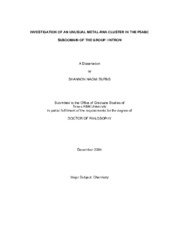| dc.contributor.advisor | DeRose, Victoria J. | |
| dc.creator | Burns, Shannon Naomi | |
| dc.date.accessioned | 2006-04-12T16:03:44Z | |
| dc.date.available | 2006-04-12T16:03:44Z | |
| dc.date.created | 2004-12 | |
| dc.date.issued | 2006-04-12 | |
| dc.identifier.uri | https://hdl.handle.net/1969.1/3167 | |
| dc.description.abstract | This dissertation focuses on the spectroscopic and thermodynamic characterization of the unusual metal-RNA cluster found in the P5abc subdomain of the Tetrahymena group I intron. The P5abc subdomain is a part of the P4-P6 domain found in the Tetrahymena thermophila group I intron selfsplicing RNA. From both X-ray crystal structures of the P4-P6 domain, a remarkable cluster of Mg2+ or Mn2+ ions was found in the P5abc subdomain
(Cate et al. 1996; Juneau et al. 2001). It is believed that the metal ion core in the
P5abc subdomain stabilizes the active conformation of the RNA (Cate et al.
1996). An understanding of the role of these metal ions in facilitating the correct
structure of the P5abc subdomain provides insight into how metal ions help
overcome the folding barriers of complex RNA structures.
Under solution conditions, the properties of this uncommon metal ion core
and its influence on the truncated P5abc subdomain structure have been
investigated. Both EPR spectroscopy and thermal denaturation experiments
have been employed to search for a spectroscopic signature of metal ion core
formation and also determine the thermodynamic contribution of the metal ion
core on the stability of the folded P5abc structure.
A spectroscopic signature of metal ion core formation was assigned for
the P5abc subdomain by EPR microwave power saturation studies. Power
saturation studies of the P5abc subdomain, P4-P6 domain and corresponding
mutants reveal that the addition of 5 equivalents of Mn2+ are required for the wild type P5abc subdomain to form the metal ion core under solution conditions in 0.1 M NaCl. Results from both domain and subdomain microwave power saturation studies suggest that this technique can be applied for detecting
clustering of Mn2+ ions in other RNA structures.
The thermodynamic consequence of this metal ion core was probed by thermal denaturation techniques including UV-Vis spectroscopy and differential scanning calorimetry (DSC). DSC experiments were utilized to directly determine the thermodynamic contribution of the metal ion core. This value was determined to be an average of ∆∆G of -5.3 kcal/mol and is consistent with ∆∆G values obtained for other RNA tertiary structures. | en |
| dc.format.extent | 10935110 bytes | en |
| dc.format.medium | electronic | en |
| dc.format.mimetype | application/pdf | |
| dc.language.iso | en_US | |
| dc.publisher | Texas A&M University | |
| dc.subject | P5abc subdomain | en |
| dc.subject | Group I Intron | en |
| dc.subject | ribozymes | en |
| dc.subject | metal ions | en |
| dc.subject | spectroscopy | en |
| dc.subject | EPR | en |
| dc.subject | thermal denaturation | en |
| dc.subject | DSC | en |
| dc.title | Investigation of an unusual metal-RNA cluster in the P5abc subdomain of the group I intron | en |
| dc.type | Book | en |
| dc.type | Thesis | en |
| thesis.degree.department | Chemistry | en |
| thesis.degree.discipline | Chemistry | en |
| thesis.degree.grantor | Texas A&M University | en |
| thesis.degree.name | Doctor of Philosophy | en |
| thesis.degree.level | Doctoral | en |
| dc.contributor.committeeMember | Russell, David H. | |
| dc.contributor.committeeMember | Raushel, Frank M. | |
| dc.contributor.committeeMember | Scholtz, J. Martin | |
| dc.type.genre | Electronic Dissertation | en |
| dc.type.material | text | en |
| dc.format.digitalOrigin | born digital | en |


